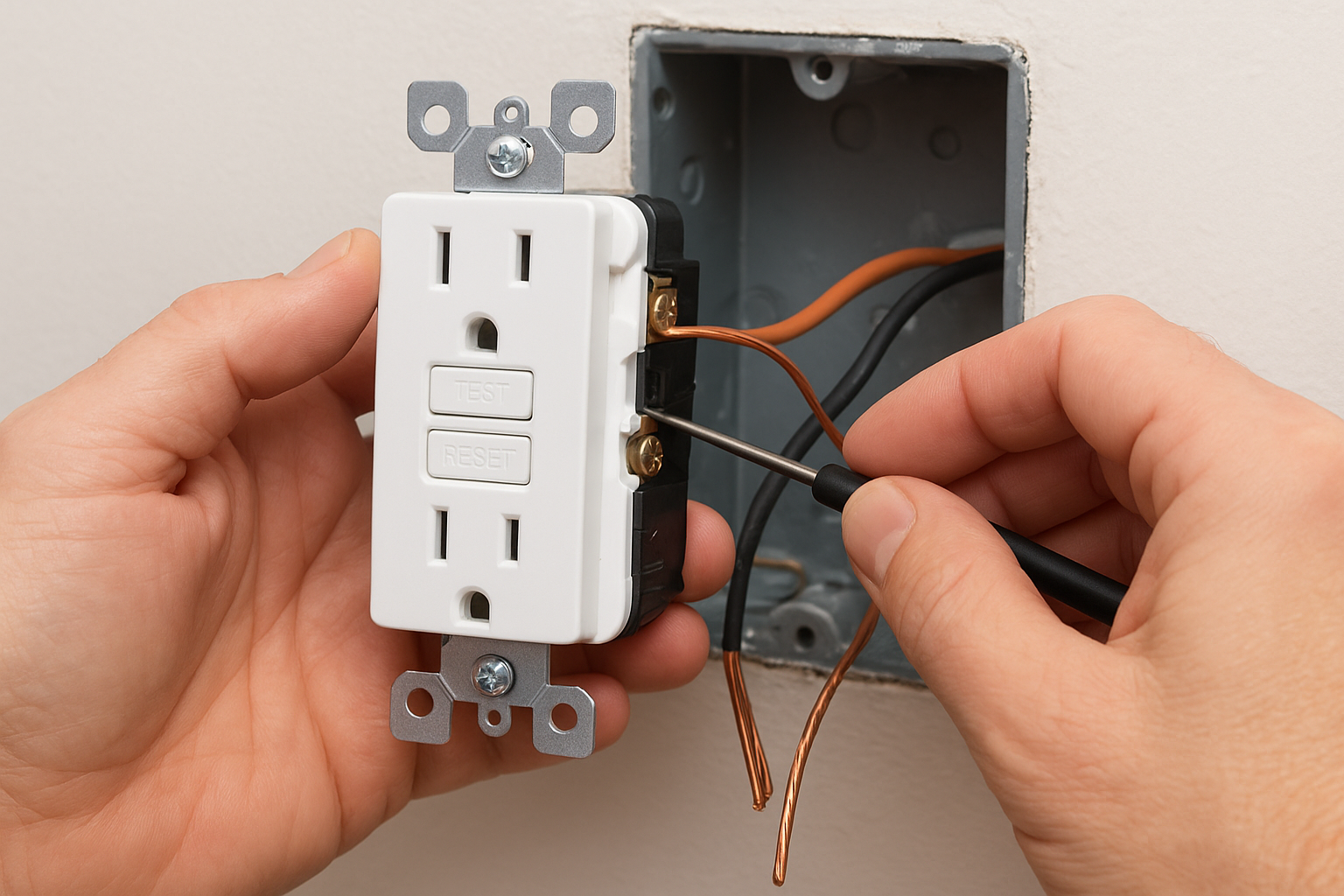
How to Wire a GFCI Outlet: Line vs Load Explained
Correctly wiring a GFCI outlet is fundamental for electrical safety, yet the distinction between line and load terminals is a common point of confusion. To wire a GFCI outlet properly, you must connect the incoming power from the circuit breaker panel to the LINE terminals. The LOAD terminals are optional and used to extend GFCI protection to other standard outlets downstream in the same circuit. Mistaking these connections is a frequent error in gfci outlet wiring. Understanding the line vs load GFCI concept is not just about functionality; it’s a critical safety requirement mandated by the National Electrical Code (NEC). Properly identifying and connecting to the GFCI line and load terminals ensures the device can detect a ground fault and interrupt the circuit, protecting individuals from electric shock.
Understanding GFCI Protection: The Basics for Professionals
As a licensed electrician, you know that safety is paramount. The Ground-Fault Circuit-Interrupter, or GFCI, is a cornerstone of modern electrical safety systems. But let’s clarify the core concepts, including the gfci meaning and its application.
So, what is GFCI? A GFCI is a fast-acting device designed to protect people from severe or fatal electric shocks. And what does gfci stand for? It stands for Ground-Fault Circuit-Interrupter. The fundamental ground-fault circuit interrupter theory is based on monitoring the balance of current between the hot (ungrounded) and neutral (grounded) conductors. If the device detects an imbalance as small as 4-6 milliamps, it assumes this current is leaking—a condition known as a ground fault—and trips the circuit in as little as 1/40th of a second. This is significantly different from a standard circuit breaker, which only trips on overloads or short circuits.
You may encounter the term gfi outlet; this is a common, informal variant of gfci outlet. For the purpose of discussion and code, gfi vs gfci are interchangeable. It’s also vital to distinguish between afci vs gfci protection. While a GFCI protects against shock, an AFCI (Arc-Fault Circuit-Interrupter) protects against fire by detecting dangerous electrical arcs. These are two distinct safety technologies, and understanding the differences is key for compliance and safety. Sometimes you might see the phrasing gfci vs afci, but the distinction remains the same.
This protection can be implemented via a gfci breaker (also called a gfci circuit breaker) at the panel, which protects the entire circuit, or at the point of use with a gfci receptacle or other gfci outlets.
The Critical Difference: Line vs Load GFCI Terminals
The most crucial aspect of a GFCI circuit installation is understanding the line vs load GFCI terminals. Improper connection is the number one reason a new GFCI fails to work or test correctly. Each gfci receptacle has two pairs of screw terminals on the back:
- LINE Terminals: These terminals are for the incoming power supply from the breaker panel (or from an upstream outlet). This is the power source. A GFCI will function and protect itself when only the LINE terminals are used.
- LOAD Terminals: These terminals are for wiring that continues downstream to feed other standard receptacles. When wired correctly, the GFCI provides GFCI feed-through protection to every outlet connected to its LOAD side, creating multi-location GFCI protection from a single device.
Proper GFCI terminal identification is straightforward. New GFCI outlets typically ship with a piece of yellow tape covering the LOAD terminals, forcing the installer to consciously acknowledge their use. If the tape is missing, the terminals are clearly marked “LINE” and “LOAD” on the back of the device.
Step-by-Step Guide: How to Wire a GFCI Outlet Correctly
Follow this professional process for a safe and compliant GFCI circuit installation. This guide explains how to wire a gfci outlet using its feed-through capabilities.
- Safety First: De-energize and Verify. Turn off the corresponding circuit breaker at the panel. Use a voltage tester or multimeter to verify that the power is off at the electrical box where you will be working. Confirm zero voltage between hot-neutral, hot-ground, and neutral-ground.
- Identify Line and Load Wires. If you are replacing an existing outlet in the middle of a run, you will likely have two sets of wires in the box. One set is the “line” (from the panel) and the other is the “load” (going downstream). To identify the line side, temporarily separate all wires, turn the breaker back on, and carefully use your voltage tester to identify which black wire is energized. This is your LINE wire. Turn the breaker off again and verify.
- Connect the Line Wires. Connect the identified LINE wires to the GFCI’s LINE terminals. The black (hot) wire connects to the brass screw, and the white (neutral) wire connects to the silver screw.
- Connect Load Wires for Downstream Protection. If you wish to protect downstream outlets, connect the “load” set of wires to the LOAD terminals. This is the load side connection GFCI. Again, connect black to brass and white to silver. This ensures any standard outlet wired after this point becomes a GFCI protected receptacle.
- Connect the Ground Wire. Connect the bare copper or green insulated ground wire to the green ground screw on the gfci receptacle.
- Install and Test the GFCI. Carefully fold the wires into the box, screw the GFCI into place, and install the faceplate. Turn the power back on. The gfci outlet should have power. To check GFCI functionality, press the “TEST” button. The “RESET” button should pop out, and power to the outlet (and any load-side outlets) should be cut. Press “RESET” to restore power. A functional gfci plug is now ready for use.
Common GFCI Wiring Scenarios and NEC Considerations
Your approach to gfci outlet wiring will vary based on the situation. Here are some common scenarios:
- End-of-Run GFCI Wiring: This is the simplest installation. The outlet is the last device on the circuit. Only one set of wires (from the panel) exists in the box. You will only use the LINE terminals. The LOAD terminals remain unused.
- GFCI Wiring in Series (Feed-Through): As described in the step-by-step guide, this involves using both LINE and LOAD terminals to provide protection to subsequent standard outlets.
- Pigtailing GFCI Outlets: If you have multiple wires in a box but only want to protect the single gfci outlet location (not downstream outlets), you can pigtail the wires. Connect the incoming and outgoing hot wires together with a third “pigtail” wire, which then connects to the GFCI’s LINE hot terminal. Do the same for the neutral and ground wires. This bypasses the load-side functionality.
- GFCI Without Ground Wire: In older properties without an equipment grounding conductor, NEC allows a two-prong receptacle to be replaced with a GFCI receptacle. This provides shock protection, though not an equipment ground. Per NEC 406.4(D)(2), the outlet must be marked “No Equipment Ground.”
Adhering to the National Electrical Code GFCI requirements is mandatory. NEC 210.8 specifies all the locations in dwelling and non-dwelling units where GFCI protection is required, including kitchens, bathrooms, garages, and outdoor areas.
Troubleshooting Common GFCI Wiring Issues
One of the most common service calls involves a gfci keeps tripping. This can be frustrating, but a systematic approach to troubleshooting GFCI wiring can quickly identify the cause.
- Reversed Line/Load Wiring: If you mix up the line and load connections, the GFCI will not reset. This is the first thing to check on a new installation.
- Actual Ground Fault: The device is doing its job. A fault could be in an appliance plugged into the GFCI or any downstream outlet, or within the wiring itself.
- Shared Neutrals: On a multi-wire branch circuit (MWBC), if the neutral is shared by another circuit downstream of the GFCI’s load side, it will create an imbalance and cause tripping.
If you have a persistent problem where a gfci keeps tripping, a deeper dive is necessary.
Primary Sources & Further Reading
This article is based on best practices and standards set by the National Fire Protection Association (NFPA). For official code reference, consult:
- NFPA 70, National Electrical Code (NEC), 2023 Edition
Frequently Asked Questions (FAQ)
What’s the difference between the line and load terminals on a GFCI outlet?
The LINE terminals are for the incoming power from the circuit breaker panel. The LOAD terminals are used to send power out to other standard receptacles, extending GFCI protection to them. Understanding this line vs load GFCI difference is essential for a correct installation.
Can you install a GFCI without a ground wire?
Yes, the NEC permits installing a GFCI without a ground wire to replace an old two-prong, ungrounded outlet. This adds critical shock protection. However, you must apply a sticker to the outlet face that reads “No Equipment Ground.”
How do you provide GFCI protection to multiple outlets using one GFCI?
You can achieve multi-location GFCI protection by using a method often called GFCI wiring in series. Wire the first outlet in the series as a GFCI, connecting the incoming power to the LINE terminals and the outgoing wires (that feed the other outlets) to the LOAD terminals. This protects all downstream receptacles.
Why does my new GFCI outlet keep tripping?
If a new gfci keeps tripping immediately after installation, the most common reason is that the LINE and LOAD wires are reversed. If wired correctly, it could indicate a ground fault in an appliance plugged in downstream or an issue like a shared neutral on the circuit. Proper troubleshooting GFCI wiring is key.
Continuing Education by State
Select your state to view board-approved continuing education courses and requirements:
Disclaimer: The information provided in this educational content has been prepared with care to reflect current regulatory requirements for continuing education. However, licensing rules and regulations can vary by state and are subject to change. While we strive for accuracy, ExpertCE cannot guarantee that all details are complete or up to date at the time of reading. For the most current and authoritative information, always refer directly to your state’s official licensing board or regulatory agency.


